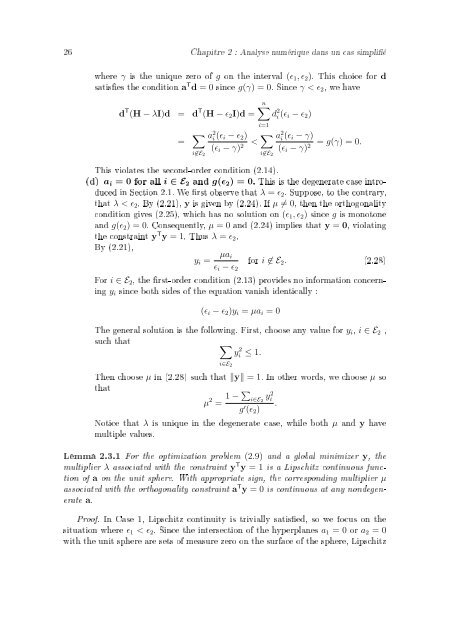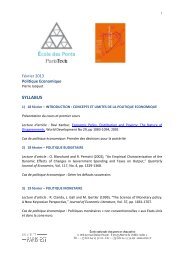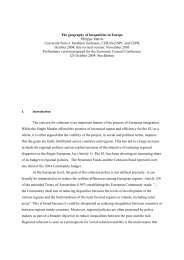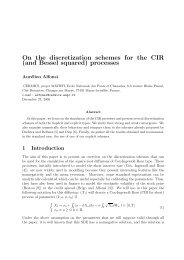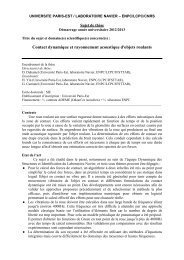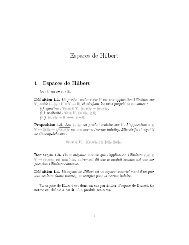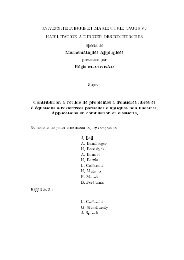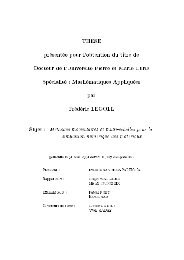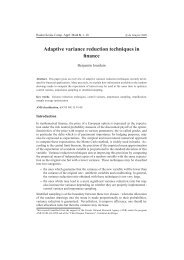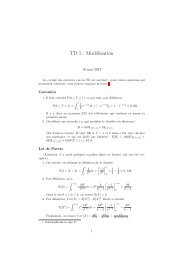You also want an ePaper? Increase the reach of your titles
YUMPU automatically turns print PDFs into web optimized ePapers that Google loves.
26 Chapitre 2 : Analyse numérique dans un cas simplié<br />
where γ is the unique zero of g on the interval (ɛ 1 , ɛ 2 ). This choice for d<br />
satises the condition a T d = 0 since g(γ) = 0. Since γ < ɛ 2 , we have<br />
d T (H − λI)d = d T (H − ɛ 2 I)d =<br />
n∑<br />
d 2 i (ɛ i − ɛ 2 )<br />
i=1<br />
= ∑ a 2 i (ɛ i − ɛ 2 )<br />
< ∑ a 2 i (ɛ i − γ)<br />
= g(γ) = 0.<br />
(ɛ i − γ) 2 (ɛ i − γ)<br />
2<br />
i∉E 2 i∉E 2<br />
This violates the second-order condition (2.14).<br />
(d) a i = 0 for all i ∈ E 2 and g(ɛ 2 ) = 0. This is the degenerate case introduced<br />
in Section 2.1. We rst observe that λ = ɛ 2 . Suppose, to the contrary,<br />
that λ < ɛ 2 . By (2.21), y is given by (2.24). If µ ≠ 0, then the orthogonality<br />
condition gives (2.25), which has no solution on (ɛ 1 , ɛ 2 ) since g is monotone<br />
and g(ɛ 2 ) = 0. Consequently, µ = 0 and (2.24) implies that y = 0, violating<br />
the constraint y T y = 1. Thus λ = ɛ 2 .<br />
By (2.21),<br />
y i =<br />
µa i<br />
ɛ i − ɛ 2<br />
for i ∉ E 2 . (2.28)<br />
For i ∈ E 2 , the rst-order condition (2.13) provides no information concerning<br />
y i since both sides of the equation vanish identically :<br />
(ɛ i − ɛ 2 )y i = µa i = 0<br />
The general solution is the following. First, choose any value for y i , i ∈ E 2 ,<br />
such that<br />
∑<br />
i∈E 2<br />
y 2 i ≤ 1.<br />
Then choose µ in (2.28) such that ‖y‖ = 1. In other words, we choose µ so<br />
that<br />
µ 2 = 1 − ∑ i∈E 2<br />
y 2 i<br />
g ′ (ɛ 2 )<br />
Notice that λ is unique in the degenerate case, while both µ and y have<br />
multiple values.<br />
<strong>Le</strong>mma 2.3.1 For the optimization problem (2.9) and a global minimizer y, the<br />
multiplier λ associated with the constraint y T y = 1 is a Lipschitz continuous function<br />
of a on the unit sphere. With appropriate sign, the corresponding multiplier µ<br />
associated with the orthogonality constraint a T y = 0 is continuous at any nondegenerate<br />
a.<br />
Proof. In Case 1, Lipschitz continuity is trivially satised, so we focus on the<br />
situation where ɛ 1 < ɛ 2 . Since the intersection of the hyperplanes a 1 = 0 or a 2 = 0<br />
with the unit sphere are sets of measure zero on the surface of the sphere, Lipschitz<br />
.


